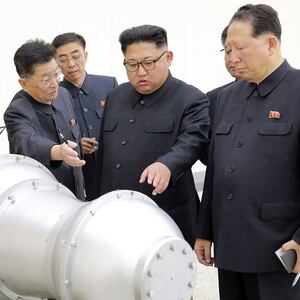Commercial satellite imagery shows North Korea is operating at least 13 and perhaps as many as 20 undeclared “missile operating bases.”
The existence of the bases, disclosed by a report issued Monday by the Washington, D.C.-based Center for Strategic and International Studies, undercuts the efforts of President Donald Trump and South Korea’s leader, Moon Jae-in, to establish ties with Kim Jong Un, the North Korean despot.
Instead of giving up missiles, the report shows North Korea is making progress developing them. “It’s not like these bases have been frozen,” Victor Cha, one the report’s three authors, told The New York Times. “Work is continuing.”
ADVERTISEMENT
The bases, which house ballistic missiles carried by mobile launchers, are of special interest to U.S. military planners. These mobile missiles can hide until an hour or so before launch, thereby decreasing the probability they will be destroyed on the ground. Missiles launched from the Sohae Satellite Launching Station, which Kim in June promised to dismantle, are vulnerable for days as they sit exposed on the pad.
David Maxwell, who served five tours of duty on the Korean Peninsula with the U.S. Army and is now at the Foundation for Defense of Democracies, suggests it’s possible that we learned of the bases at this time because the North Koreans wanted us to see them. “They may be deliberately showing us this to put pressure on us to make concessions.”
Whether or not the North Koreans purposely showed their hand, the report certainly complicates Trump’s and Moon’s diplomatic efforts. As the Times noted, “The satellite images suggest that the North has been engaged in a great deception.”
And that deception causes problems for the 45th American president. Trump, since late May, has based policy on the assumption that Kim Jong Un had made a strategic decision to surrender nuclear weapons and missiles.
Trump at the Ottawa Group of 7 meeting in June—just before his historic summit in Singapore with Kim—said he was giving the North Koreans a “one-time shot” to do the right thing. Trump hoped to create an atmosphere so friendly that Kim would feel secure enough to disarm.
Although the maintenance of the mobile missile bases does not violate the agreement Trump and Kim inked in Singapore—the document is especially vague on “denuclearization”—it nonetheless makes clear that Kim wants to hold on to missiles.
Monday’s report, therefore, looks like an emperor-has-no-clothes moment for Trump.
Although Trump policy looks particularly unsuccessful at the moment, Kim should not get too comfortable. He is, after all dealing with a leader who can change policy without notice and bring to bear the power of America.
Just ask Chinese ruler Xi Jinping. All last year, Trump made gushing statements about Xi as the American hoped to obtain Xi’s cooperation on, among other things, North Korea. China’s supremo ultimately disappointed Trump, so this year Trump turned hostile, imposing tariffs and taking other actions that made life difficult for Xi’s China.
It’s not clear what persuaded Trump to change course, but Xi obviously pushed Trump too far, wasting an opportunity to work cooperatively. Should Trump feel Kim has embarrassed him by, for instance, proceeding with his missile program at full speed, Trump may do to him what he did to Xi; in other words, turn mean.
Trump, for instance, could vigorously enforce sanctions that he, as a practical matter, let lapse. He could also cut off cash flowing to the regime by going after the big Chinese banks that have been handling money for Kim. Kim’s North Korea is not in a strong position to withstand Trump anger—and American power.
Kim’s mobile missile program causes even more problems for Moon Jae-in, who is staking his tenure on promoting Kim Jong Un to South Korean voters and Trump. The CSIS report reveals Sakkanmol, a base housing short-range ballistic missiles only 135 kilometers northwest of Seoul. Sakkanmol is undoubtedly where the North Koreans store the missiles that could one day rain down on the South Korean capital.
News about Sakkanmol undermines most of what Moon says about Kim. “The recent exposure of North Korea’s hidden facility for short-range missiles—the ones that can reach South Korea—shows that the North is not reducing its threats,” Tara O of Pacific Forum told me. “North Korea also is mobilizing for wartime, telling its people to leave work to report to training centers to train for wartime, so while the Moon administration is busy reducing South Korea’s defense capability and sending tangerines to North Korea, Kim Jong Un pursues acts that cannot be described as ‘peaceful.’”
Moon has so far been able to promote his vision of a benign Kim to the South Korean public, but the revelation about Sakkanmol tests his credibility. And that could delay Moon’s plans to sell unification of the two Koreas to his constituents.
In the last few hours, a North Korea missile expert told me that the CSIS report looks flawed, but the accuracy of its assertions is not what matters. The report, accurate or not, delegitimizes Kim’s biggest booster—Moon Jae-in—and probably angers his best new friend, Donald Trump.
Kim, therefore, is probably not going to like what happens next.







